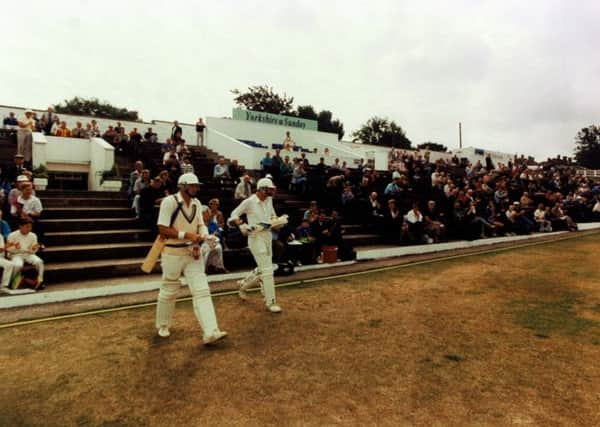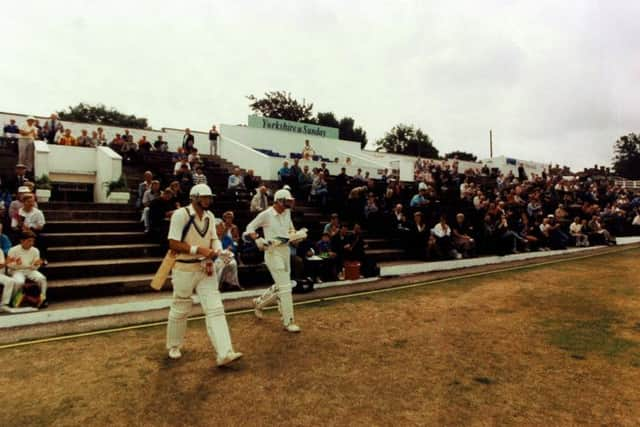POLL: Proposed return to Bradford is reminder of Yorkshire’s great diversity down the years


Fifty years earlier, when the competition was almost twice as long and one-day cricket a fleeting sideshow, they played 17 of their 28 Championship games at outgrounds – a staggering 60.71 per cent.
Back in 1965, in addition to three matches at their Headingley headquarters, Yorkshire played three games at Bradford and Sheffield, two at Scarborough, and one each at Harrogate, Middlesbrough and Hull.
Advertisement
Hide AdAdvertisement
Hide AdOutside Yorkshire, they visited the outgrounds of Chesterfield, Swansea, Gillingham, Portsmouth, Leyton and Lydney, the latter one of only eight first-class fixtures ever staged at the Gloucestershire venue.


The conclusion, if you had not already guessed, is that fings ain’t wot they used t’be and that cricket at outgrounds is in terminal decline, rather like print journalism and the art of letter-writing.
Indeed, go back further into the mists of time, and the Yorkshire fixture list would have embraced such long-forgotten home venues as Dewsbury, Hunslet, Holbeck and Wakefield, all left behind in the name of progress.
Yorkshire, in fact, have played at so many grounds in this vast and vibrant county that I am frightened to list them for fear of missing any out.
Advertisement
Hide AdAdvertisement
Hide AdDiversity was always one of Yorkshire’s great strengths; outgrounds were always one of cricket’s great strengths.
That is why the proposed redevelopment of Bradford Park Avenue, which dropped off the first-class list back in 1996, is music to the ears of the cricketing romantic.
The ground, one of the most famous of Yorkshire’s “lost” cricket venues, might not have been as aesthetically pleasing as some of its national counterparts but it had character aplenty – and plenty of characters.
Bradford was arguably the most popular of Yorkshire’s outgrounds among the players themselves, possessed as it was of a vivid atmosphere and the slightly intimidating nickname “The Bullring”.
Advertisement
Hide AdAdvertisement
Hide AdDerek Hodgson, the Yorkshire cricket writer, said Park Avenue was “thought by many members and supporters to be the most ‘Yorkshire’ of all the county grounds, dominated by a stylish old Victorian pavilion that always seemed on the point of collapse, with two sides of the ground white-walled and fronted by wooden benching.”
Hodgson went on: “For most of its life the end opposite the pavilion was occupied by the rear of the Bradford Park Avenue Football Club’s grandstand, surmounted by a clock, a recognised target for the big hitter.
“The small playing area, particularly straight, made it a hazardous ground for spinners and both Rhodes and Verity suffered for their art before Bradford’s shrewd and perceptive crowd.”
JM Kilburn, once of this parish, called Bradford “a neatly fashioned ground, strictly business-like in its appeal for cricket”, and said that “to show its best face (it) needs the smartening of fresh paint, tidy terracing and well-preserved pathways. The dust of its environment and the litter of occasions past soon leave it looking forlorn in emptiness.”
Advertisement
Hide AdAdvertisement
Hide AdSadly, “forlorn” is the word that best describes Park Avenue today, left derelict by circumstance and cricketing change.
The proposed redevelopment could see Yorkshire playing first-class cricket there as early as 2019, when there is pressure on the international calendar at Leeds, but, essentially, it is about providing more opportunities for Bradford’s cricketing community, with nets and practice pitches for schools and clubs, and the desire to engage with the Asian populace.
The project, a laudable partnership between the Yorkshire club, the England and Wales Cricket Board and Bradford Metropolitan District Council, should breathe life into one of Yorkshire’s great spiritual homes.
It is a home for which the likes of Bob Appleyard, the former Yorkshire and England seam and spin bowler, have fought tirelessly over the years, through such worthy initiatives as the Friends of Park Avenue, and how fitting it would be if Bob – who would celebrate his 95th birthday in 2019 –was there to see first-class cricket return to a venue that is part of his very soul.
Advertisement
Hide AdAdvertisement
Hide AdYorkshire, who first played at Bradford in 1881, have suffered more than anyone from the systematic erosion of outground cricket.
The reason for that erosion is simply explained; as commercial pressures have increased, resulting in greater expectation in terms of facilities and pitches, so clubs have struggled to justify non-major grounds from a financial perspective, while cricket has changed and society too, with less Championship games in a T20 era – one of short attention spans, a cornucopia of competing entertainments and intolerable time pressures on all and sundry.
The tectonic plates of the sport have shifted steadily since Yorkshire’s eclectic fixture list from 1965. As international cricket has grown out of hand (so much so, in fact, that it really needs liposuction), and the clamour to stage it intensified with feverish ferocity, so clubs have concentrated on developing headquarters such as Headingley to stay afloat in an increasingly competitive marketplace.
The trend, alas, can never be reversed, but how we wish Yorkshire, the ECB and the local authority well with their Bradford project, which will hopefully bring a grand old outground back to life and a smile to the face of Appleyard and company.